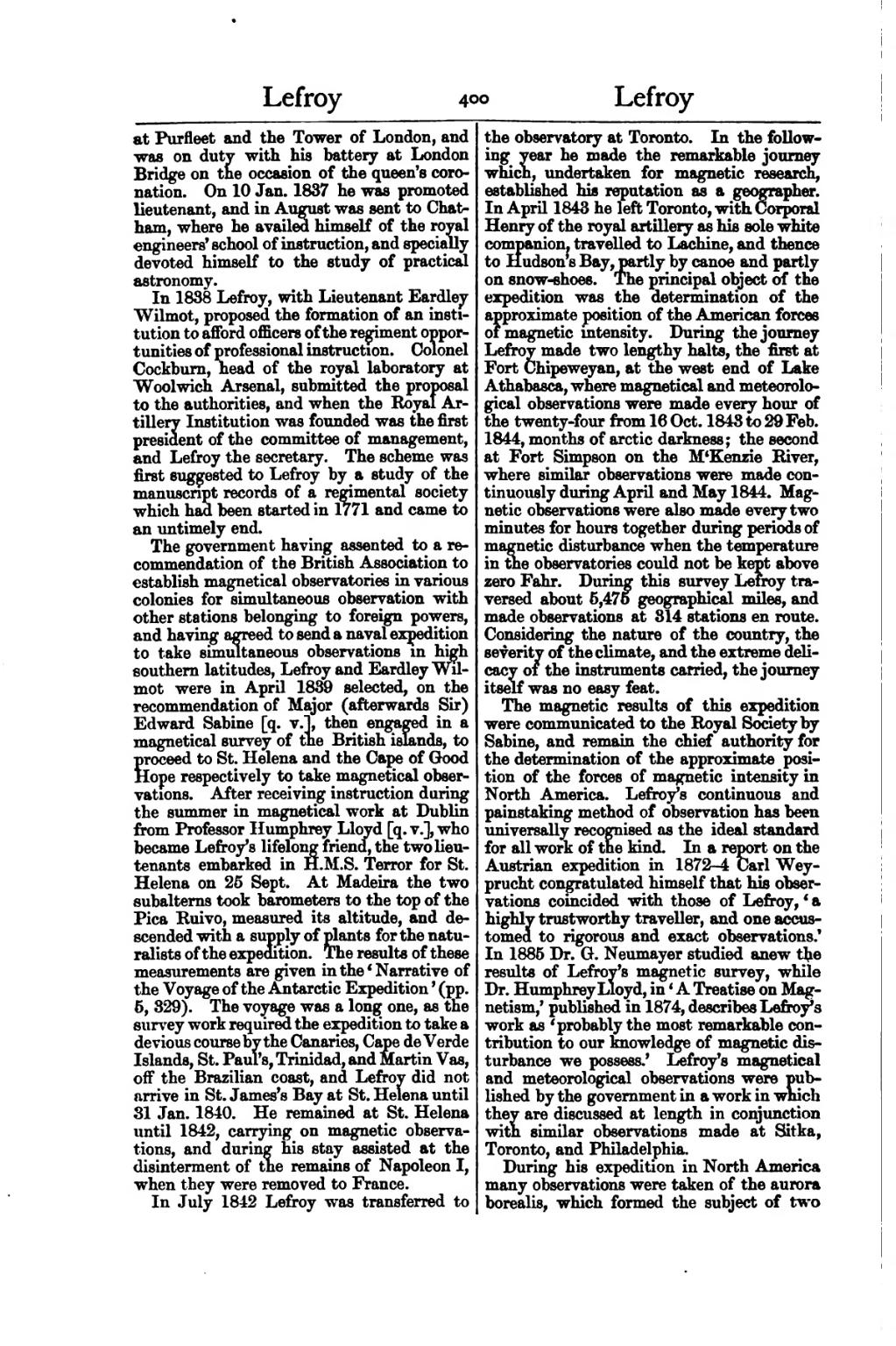at Purfleet and the Tower of London, and was on duty with his battery at London Bridge on the occasion of the queen's coronation. On 10 Jan. 1837 he was promoted lieutenant, and in August was sent to Chatham, where he availed himself of the royal engineers' school of instruction, and specially devoted himself to the study of practical astronomy.
In 1838 Lefroy, with Lieutenant Eardley Wilmot, proposed the formation of an institution to afford officers of the regiment opportunities of professional instruction. Colonel Cockburn, nead of the royal laboratory at Woolwich Arsenal, submitted the proposal to the authorities, and when the Royal Artillery Institution was founded was the first president of the committee of management, and Lefroy the secretary. The scheme was first suggested to Lefroy by a study of the manuscript records of a regimental society which had been started in 1771 and came to an untimely end.
The government having assented to a recommendation of the British Association to establish magnetical observatories in various colonies for simultaneous observation with other stations belonging to foreign powers, and having agreed to send a naval expedition to take simultaneous observations in high southern latitudes, Lefroy and Eardley Wilmot were in April 1839 selected, on the recommendation of Major (afterwards Sir) Edward Sabine [q. v.l, then engaged in a magnetical survey of the British islands, to proceed to St. Helena and the Cape of Good Hope respectively to take magnetical observations. After receiving instruction during the summer in magnetical work at Dublin from Professor Humphrey Lloyd [q. v.], who became Lefroy's lifelong friend, the two lieutenants embarked in H.M.S. Terror for St. Helena on 25 Sept. At Madeira the two subalterns took barometers to the top of the Pica Ruivo, measured its altitude, and descended with a supply of plants for the naturalists of the expedition. The results of these measurements are given in the ' Narrative of the Voyage of the Antarctic Expedition ' (pp. 6, 329). The voyage was a long one, as the survey work required the expedition to take a devious course by the Canaries, Cape de Verde Islands, St. Paul's, Trinidad, and Martin Vas, off the Brazilian coast, and Lefroy did not arrive in St. James's Bay at St. Helena until 31 Jan. 1840. He remained at St. Helena until 1842, carrying on magnetic observations, and during his stay assisted at the disinterment of the remains of Napoleon I, when they were removed to France. In July 1842 Lefroy was transferred to the observatory at Toronto. In the following year he made the remarkable journey which, undertaken for magnetic research, established his reputation as a geographer. In April 1843 he left Toronto, with Corporal Henry of the royal artillery as his sole white companion, travelled to Lachine, and thence to Hudson s Bay, partly by canoe and partly on snow-shoes. The principal object of the expedition was the determination of the approximate position of the American forces of magnetic intensity. During the journey Lefroy made two lengthy halts, the first at Fort Chipeweyan, at the west end of Lake Athabasca, where magnetical and meteorological observations were made every hour of the twenty-four from 16 Oct. 1843 to 29 Feb. 1844, months of arctic darkness; the second at Fort Simpson on the M'Kenzie River, where similar observations were made continuously during April and May 1844. Magnetic observations were also made every two minutes for hours together during periods of magnetic disturbance when the temperature in the observatories could not be kept above zero Fahr. During this survey Lefroy traversed about 6,475 geographical miles, and made observations at 314 stations en route. Considering the nature of the country, the severity of the climate, and the extreme delicacy of the instruments carried, the journey itself was no easy feat.
The magnetic results of this expedition were communicated to the Royal Society by Sabine, and remain the chief authority for the determination of the approximate position of the forces of magnetic intensity in North America. Lefroy's continuous and painstaking method of observation has been universally recognised as the ideal standard for all work of the kind. In a report on the Austrian expedition in 1872-4 Carl Weyprucht congratulated himself that his observations coincided with those of Lefroy, 'a highly trustworthy traveller, and one accustomed to rigorous and exact observations.' In 1885 Dr. G. Neumayer studied anew the results of Lefroy's magnetic survey, while Dr. Humphrey Lloyd, in 'A Treatise on Magnetism.' published in 1874, describes Lefroy's work as 'probably the most remarkable contribution to our knowledge of magnetic disturbance we possess.' Lefroy's magnetical and meteorological observations were published by the government in a work in which they are discussed at length in conjunction with similar observations made at Sitka, Toronto, and Philadelphia.
During his expedition in North America many observations were taken of the aurora borealis, which formed the subject of two
